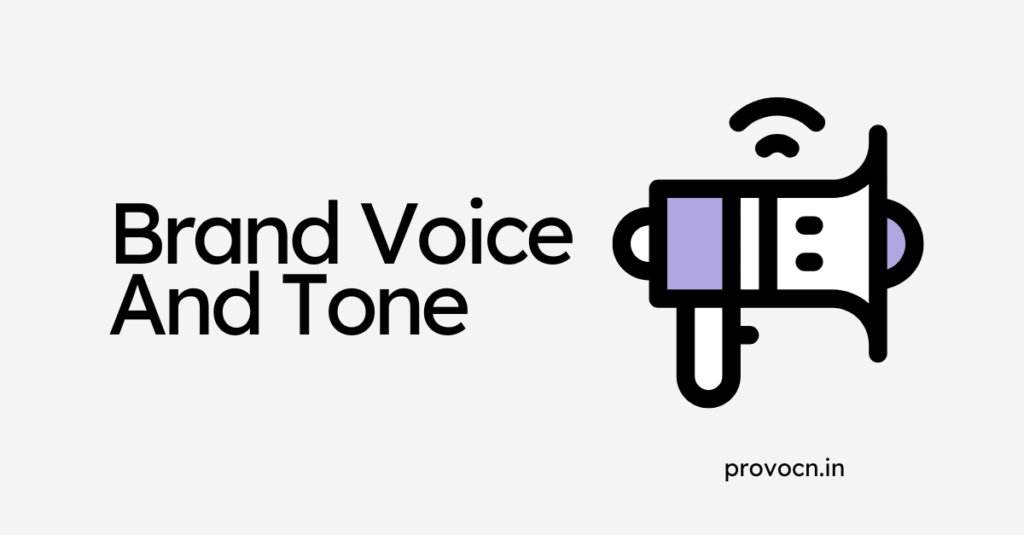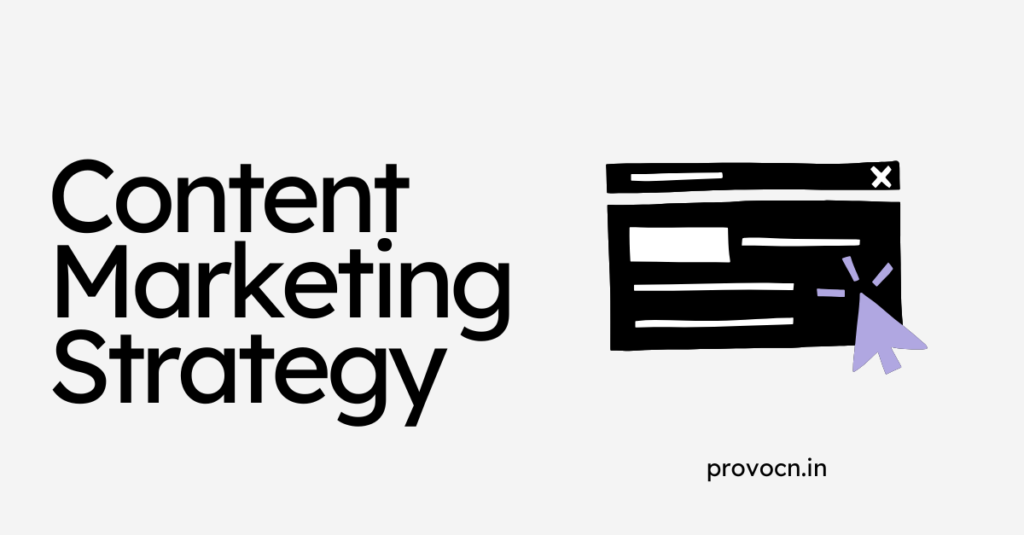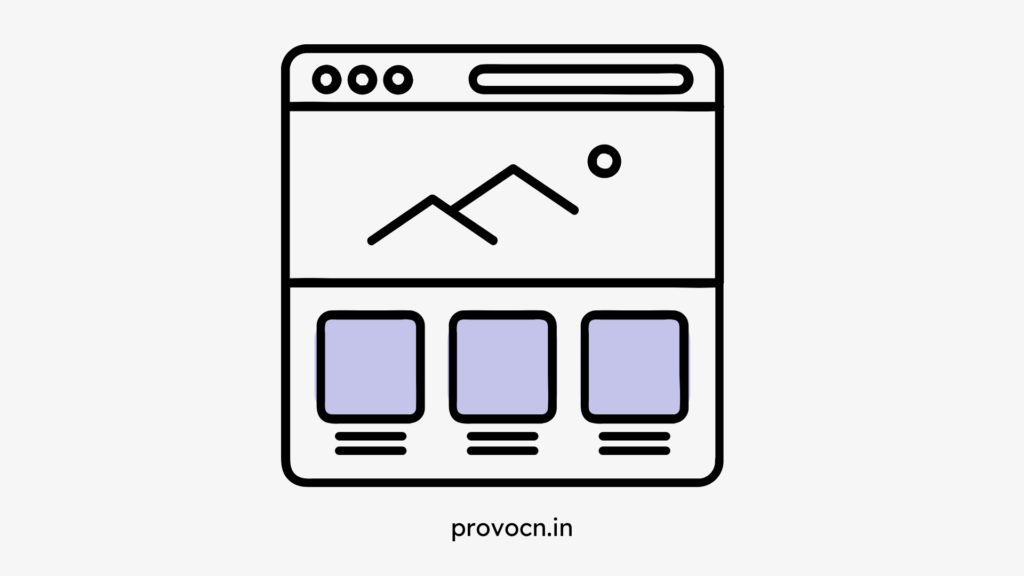How To Develop Your Brand’s Voice And Tone?
Published on January 7, 2025 by Anisha Patel

Brand voice and tone are two important elements that separates your brand from your competitors. They are cornerstones of how your brand communicates and reflects your brand’s personality.
Overlooking tone and voice is a problem as it can alienate your audience. Finding a consistent, authentic voice that resonates with your target market can be challenging, but it’s a must for building trust.
In this blog, I’ll help you understand what brand voice and tone are, their benefits and how to develop them for your brand.
What Is Tone And Voice?
Voice and tone are two of the most important elements of branding. They define how your brand communicates and how your audience perceives and connects with your brand.
Let’s understand the both of them in details.
Brand Voice
It represents the brand’s consistent personality, character and overall style of communication. It is rooted in the brand’s values, mission, and identity.
Think of voice as the “character” of your brand — it doesn’t change and defines who your brand is at its core.
Some key characteristics of brand voice are:
- Unique: Reflects your brand’s essence, making it distinct from competitors.
- Consistent: Remains the same across all touchpoints, from website copy to customer support emails.
- Authentic: Aligns with your brand’s purpose and promises.
Let’s look at some examples:
- Nike: “Greatness isn’t born. It’s made.”
- Coca-Cola: “Taste the feeling.”
- Apple: “Think different.”
Brand Tone
It is how the brand voice is expressed in different situations, mediums or audiences. While the voice remains constant, the tone adapts to match the context, mood and purpose of the communication.
Some key characteristics of brand tone are:
- Flexible: Changes based on the audience, platform or message.
- Contextual: Adjusts to reflect the emotional state of the audience or the goal of the communication.
- Purpose-driven: Ensures the brand voice resonates more effectively in specific situations.
Let’s look at some examples:
- A healthcare brand:
- Reassuring Tone: “We’re here to support you every step of the way.” (For FAQs)
- Empathetic Tone: “We understand this is a challenging time.” (For patient stories)
- A tech brand:
- Playful Tone: “Let’s make technology fun again!” (For social media)
- Informative Tone: “Step 1: Plug in the device. Step 2: Follow the on-screen instructions.” (For manuals)
Brand Voice Vs. Brand Tone
| Aspect | Brand Voice | Brand Tone |
| Definition | The brand’s unique personality and consistent way of communicating. | The emotional feeling or style added to the brand’s voice to match the situation. |
| Consistency | Remains the same across all communications. | Changes depending on the audience, context or platform. |
| Purpose | Defines the core identity of the brand. | Makes the communication relevant and relatable in specific scenarios. |
| Example | Apple’s voice is sleek, innovative, and minimalist. | Apple’s tone might be warm in marketing emails but formal in a warranty. |
Benefits Of Tone And Voice
The benefits of having a clear and consistent tone and voice in content marketing are numerous and play a crucial role in building a strong brand identity and fostering customer relationships:
1. Builds Recognition and Trust: A consistent voice makes your brand easily recognisable and trustworthy. People know what to expect when interacting with you.
2. Fosters Connection: A well-defined tone helps tailor communication to resonate with your audience’s emotions and needs.
3. Strengthens Brand Identity: Voice and tone together reinforce your brand’s identity and make it memorable.
4. Ensures Clarity Across Teams: Having clear guidelines for voice and tone ensures all departments (marketing, sales, and customer support) communicate cohesively.
5. Differentiates Your Brand: In a crowded market, a unique voice and a strategic tone help your brand stand out and remain relevant.
How To Build Tone And Voice For Your Brand?
Building a strong tone and voice for your brand is essential for creating a consistent, authentic and memorable presence. This 7-steps process will help your develop the right tone and voice for your brand:
- Step 1: Understand your brand’s personality
- Step 2: Create a brand voice framework
- Step 3: Define your tone
- Step 4: Use language that reflects your brand
- Step 5: Develop guidelines for different platforms
- Step 6: Incorporate feedback and evolve
- Step 7: Document the voice and tone guidelines
Step 1: Understand Your Brand’s Personality
The first step of building a strong and authentic brand starts with understanding its personality. A well-defined brand personality shapes how your audience looks at your business.
A]. Define Your Brand’s Core Values: Core values builds the foundation of your brand. It tells what your brand stand for. These values influence every aspect of your business, from the way you communicate to the products or services you offer.
- Mission, Vision, and Values: Start by finding your brand’s mission (what you aim to do), vision (where you want to go), and values (principles guiding your business). They form the heart of your brand’s personality.
- Personality Traits: Decide the kind of personality you want your brand to project. This could be friendly, professional, playful, authoritative, luxurious or any other characteristic that aligns with your values and business goals.
B]. Know Your Audience: Your audience should always be at the center of your brand personality. To connect with them you need to understand who they are, what they care about and how they prefer to communicate.
- Demographics: Gather data about your target audience, including their age, gender, location, income, education and occupation. This information helps tailor your messaging.
- Preferences and Pain Points: Dive deeper into their likes, dislikes, aspirations, and challenges. Addressing their pain points with empathy and clarity makes your brand relatable and trustworthy.
- Communication Style: Learn how your audience prefers to be spoken to. Are they drawn to humor, formal language or a mix of both?
C]. Competitive Analysis: Understanding your competition at this stage allows you to find opportunities to stand out and create a unique voice.
- Review Competitors: Analyse how competitors in your industry communicate. Look at their tone, style and key messages. Identify patterns or trends in their approach.
- What Works: Identify the elements of their communication that resonate with your shared audience.
- Identify Gaps: Look for areas where competitors are lacking or inconsistent. Use these gaps as opportunities to craft a distinct and consistent brand voice.
By focusing on these three areas, core values, audience understanding, and competitive analysis, you can shape a brand personality that not only reflects your business but also connects deeply with your audience.
Step 2: Create a Brand Voice Framework
Your brand voice is the unique way your business communicates with your audience. It consist of the tone, language and style used across all platforms which makes your brand recognizable and relatable.
Developing a structured framework will ensures that your voice remains consistent and aligned with your brand personality. Here’s how to do it:
A]. Voice Characteristics: Define the specific traits that make up your brand’s voice. These characteristics should reflect your core values and resonate with your audience.
- Formal or Informal: Decide how polished or casual your communication should be.
- Playful or Serious: Choose between a lighthearted, fun approach or a serious, straightforward style.
- Inspirational or Direct: Determine whether to motivate your audience with visionary messaging or provide clear, concise instructions.
- Empathetic or Authoritative: Balance understanding and expertise based on your brand’s purpose.
B]. Consistency is Must: A consistent brand voice is essential for building trust, recognition, and loyalty among your audience. Here’s how to maintain it:
- Document your brand voice traits in a style guide. Include examples, dos and don’ts and descriptions of how to adapt the tone for different scenarios.
- Whether it’s your website, social media, email campaigns or customer service responses ensure the same voice is used everywhere.
- If multiple people contribute to your content, provide training to ensure everyone understands and applies the voice framework.
- Regularly review your communication to ensure consistency and relevance. Update the framework as your brand evolves or if audience preferences change.
By developing a clear brand voice framework, your business can create cohesive messaging that strengthens its identity and builds deeper connections with your audience.
Step 3: Define Your Tone
The different between brand tone and voice is simple.
- Voice: The consistent personality of your brand that doesn’t change. It’s the what you say.
- Tone: The variation in how the voice is delivered based on context. It’s the how you say it.
Your tone is how your brand voice is expressed in different contexts. Brand voice remains constant and represents your personality and core values. But tone adjusts depending on the situation, audience or platform.
Defining your tone will ensure that your communication is adaptable while staying true to your brand identity. The most common tone used by brands are:
- Friendly and Approachable
- Professional and Authoritative
- Playful and Witty
- Inspirational and Uplifting
- Sophisticated and Elegant
- Bold and Edgy
- Sincere and Honest
- Informative and Educational
- Empathetic and Supportive
By defining your tone, you get flexibility in how your brand communicates without losing its core identity. This helps you connect with your audience deeply across various platforms and situations.
Step 4: Use Language that Reflects Your Brand
The language you use is a direct reflection of your brand’s identity. It shapes how your audience looks at your business and determines how effectively you communicate your message.
It’s important to be intentional and careful with your word choice and sentence structure to ensure your language aligns perfectly with your brand personality.
Let’s look at word choices and sentence structure one by one.
1. Word Choice: The words you use should reflect your brand’s essence and appeal to your target audience.
- Reflect Your Brand’s Personality: If your brand is fun and youthful, add casual language, humour or even slang. This makes your messaging feel relatable and engaging, especially for younger audiences.
- Create the Right Tone: Choose words that evoke the emotions you want your audience to feel. For example: To inspire, use action-oriented and positive language.
- Avoid Inconsistencies: Stay true to your brand voice and avoid language that could confuse or alienate your audience.
B]. Sentence Structure: How you structure your sentences impacts how your message is received. Adjust the length and style of sentences based on your tone and the context of your communication.
- Use brief, impactful sentences to create a sense of urgency, excitement, or boldness. This style is ideal for headlines, social media, or calls to action.
- When your message requires depth or explanation, opt for longer, more descriptive sentences. This works well for blogs, reports or emails where detail is necessary.
- Combining short and long sentences adds rhythm and keeps your writing engaging.
- Regardless of sentence structure, prioritize clarity. Avoid jargon or overly complex phrasing that could confuse or disengage your audience.
By being mindful of your word choice and sentence structure, you can create content that consistently reflects your brand’s personality, connects with your audience and delivers your message.
Step 5: Develop Guidelines for Different Platforms
Every platform is different. Each have a different purpose, caters to a different audience and speaks a different language.
To maintain consistency, your brand voice must remain the same across all channels. But your tone should adapt to fit the specific platform’s norms and the audience it serves.
Here’s how you can effectively develop platform-specific guidelines:
1. Social Media: The vibe of most of social media is chill. While maintaining your consistent voice you can make tone conversational, friendly and engaging. Try to create content that encourages interaction.
You can easily be washed away in the fast-paced nature of social platforms. So, use emojis, hashtags and short but catchy sentences to grab attention.
Keep you responses quick and conversational to gain engagement. For example: “Thanks for the shoutout! Glad you’re loving it. 💙”
2. Corporate Blog: The vibe of corporate blog is informative, authoritative and educational. Maintain your consistent brand voice and try to write longer, structured content with subheadings, bullet points and a professional yet approachable tone.
3. Email Marketing: The vibe of email marketing is personalized and direct. Content can vary from promotional to formal depending on the content type.
Use concise subject lines, clear calls-to-action and a tone that aligns with the email’s purpose (nurturing leads or promoting sales).
Keep the tone of your email responses formal with detailed responses.
For example: “We appreciate your feedback and are glad to assist further. Please let us know how we can improve your experience.”
4. Customer Support Channels: The vibe of customer care is empathetic, polite and solution-oriented. Avoid using jargon and use a clear, simple language to make your audience feel heard and valued.
Create language guidelines for support teams to ensure consistency in empathy, tone and resolution-focused communication. Start conversational with acknowledgement, then offer assistance and finally close with reassurance.
Step 6: Incorporate Feedback and Evolve
Your brand voice is not a one-time thing. It requires regular assessment and adjustments to make it continuously resonate with your target audience and keep up with your evolving business goals.
And to do so, incorporating feedback and allowing your brand voice to evolve. It will make sure your brand remains authentic, engaging, and aligned with both your audience and your business journey.
- Monitor audience response across channels, such as social media comments, customer reviews, or direct interactions. Pay attention to what your audience says about your content, tone, and messaging.
- Conduct Surveys and Polls and directly ask your audience for feedback through surveys or polls.
Analyze the results to identify strengths and areas for improvement.
- As your business expands, your brand voice may need to mature or shift. For example: A startup might initially use an enthusiastic tone but as the business grows, a more polished and authoritative voice might better reflect its status.
- Your target audience’s demographics, preferences and expectations can change with time, so regularly revisit your brand guidelines and if your audience evolves, adjust your tone and voice without any delay.
- Any cultural shift or industry trend that influence communication style with your target audience, embrace it. But don’t forget to remain true to your core values and identity while including these changes.
Step 7: Document the Voice and Tone Guidelines
A well-documented brand voice guide will help you maintain consistency across all your communication channels. It will serve as a reference point for everyone involved in creating content for your brand.
Here’s what you can add in your brand voice and tone guidelines:
- Brand’s character traits ( friendly, innovative, professional)
- Brand’s voice (formal or informal, playful or serious, empathetic or authoritative)
- Tone variations, how your tone changes based on context (blog, emails, social media).
- A list of preferred words and phrases that aligns with you brand identity
- Sentence style outline
- Visual examples (screenshots, mockups) of how guidelines should be applied in real scenarios (website, email, social media)
Next, make it accessible and practical. Here’s how you can do it:
- Centralise documents by storing them in a shared location (cloud-based platform) where all team members and collaborators can easily access them.
- Use the guide as a core component of training new employees or partners to ensure they understand and can apply your brand voice effectively.
- Regularly revisit and revise the guide to add changes in your brand’s strategy, audience or industry trends.
Final Words
Mastering your brand’s voice and tone isn’t just about words. It’s about creating an experience that aligns with your values and connects with your audience on a deeper level.
A consistent voice ensures your brand remains authentic and recognizable, while a flexible tone allows your communication to resonate in different contexts.
By defining and documenting every aspect of it you can build a strong brand and stand out in a competitive marketplace.








